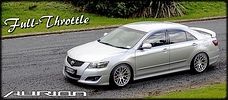l SIC l wrote:Oh... dicks.

What's the Legal DB limit these days anyway? Is it 90-93?
(a) in the case of a moped (LA or LB‐Class), 91 dBA; or
(b) in the case of a motorcycle with an engine capacity of 125 cc or less (LC,
LD or LE‐Class), 96 dBA; or
(c) in the case of a motorcycle with an engine capacity of more than 125 cc
(LC, LD or LE‐Class), 100 dBA; or
(d) in the case of an MA, MB, MC, MD1, MD2, or NA‐class vehicle that was
manufactured before 1 January 1985, 95 dBA; or
(e) in the case of an MA, MB, MC, MD1, MD2, or NA‐class vehicle that was
manufactured on or after 1 January 1985:
(i) if first registered in New Zealand before 1 June 2008, 95 dBA; or
(ii) if first registered in New Zealand on or after 1 June 2008, 90 dBA.
NOTE 1: The decibel figures specified in 2.9(1) are the figures set by the Government, as specified in Land
Transport Rule: Vehicle Equipment Amendment 2011, and may change from time to time as
Government policy dictates. Such changes will be reflected in an amendment to this low volume
vehicle standard.
NOTE 2: ‘dB’ refers to ‘decibels’, and the ‘A’ denotes ‘A‐weighted decibels’, which is an adjustment process that
takes into account the varying sensitivity of the human ear, to different decibel levels at different
frequencies. Low frequency sounds are quieter to the human ear. The ‘A’ weighting curve primarily
takes into account the 500‐10,000 Hz frequency range.
Decibel factoring for specific situations
2.9(2) A factor of 4 dBA may be subtracted from the average decibel level recorded in
2.8(13), in order to compensate for the increased background noise caused by
the close proximity of the engine to the exhaust outlet, in the case of a low
volume vehicle, other than a motor‐cycle, that has either:
(a) the engine positioned to the rear of the driver; or
(b) the exhaust outlet positioned within 1.5 metres (5 feet) of the engine.
2.9(3) A factor of 2 dBA may be subtracted from the average decibel level recorded in
2.8(13), in the case of a low volume vehicle, other than a motor‐cycle or one that
has the factor specified in 2.9(2) already applied, that incorporates a particular
type of engine, or engine equipment or components, that emits an unusually high
level of mechanical sound, if the low volume vehicle certifier believes that the
exhaust noise emission figure may be influenced by that engine type, equipment,
or components.
LVVTA Low Volume Vehicle Standard 90‐20(03) (Exhaust Noise Emissions) Page 19 of 22
© Low Volume Vehicle Technical Association (Inc.) December 2011
2.9(4) A factor of 5 dBA may be subtracted from the average decibel level recorded in
2.8(13), in the case of a scratch‐built low volume vehicle of scratch‐built subcategory
‘Historic Replica’, or scratch‐built sub‐category ‘Reproduction’, first
registered in New Zealand on or after 1 June 2008, that is a replication or
reproduction of a vehicle manufactured before 1 January 1985.
NOTE 1: An engine type referred to in 2.9(3) is typically a diesel engine or an air‐cooled engine, and the
components or equipment referred to in 2.9(3) may include cooling fans, mechanical belt‐driven
superchargers, gear‐driven camshafts and balance shafts, belt‐driven primary drives, and dry
clutches. In order for such components to have an influence on the exhaust noise emission testing, it
will generally either have no effective shielding surrounding it, or be positioned within two metres (six
feet) of the sound level meter microphone.
NOTE 2: In a case where shielding around the vehicle is used as described in 2.7(3), the decibel factoring noted
in 2.9(2) and 2.9(3) cannot be applied.
http://www.lvvta.org.nz/documents/stand ... ssions.pdf
